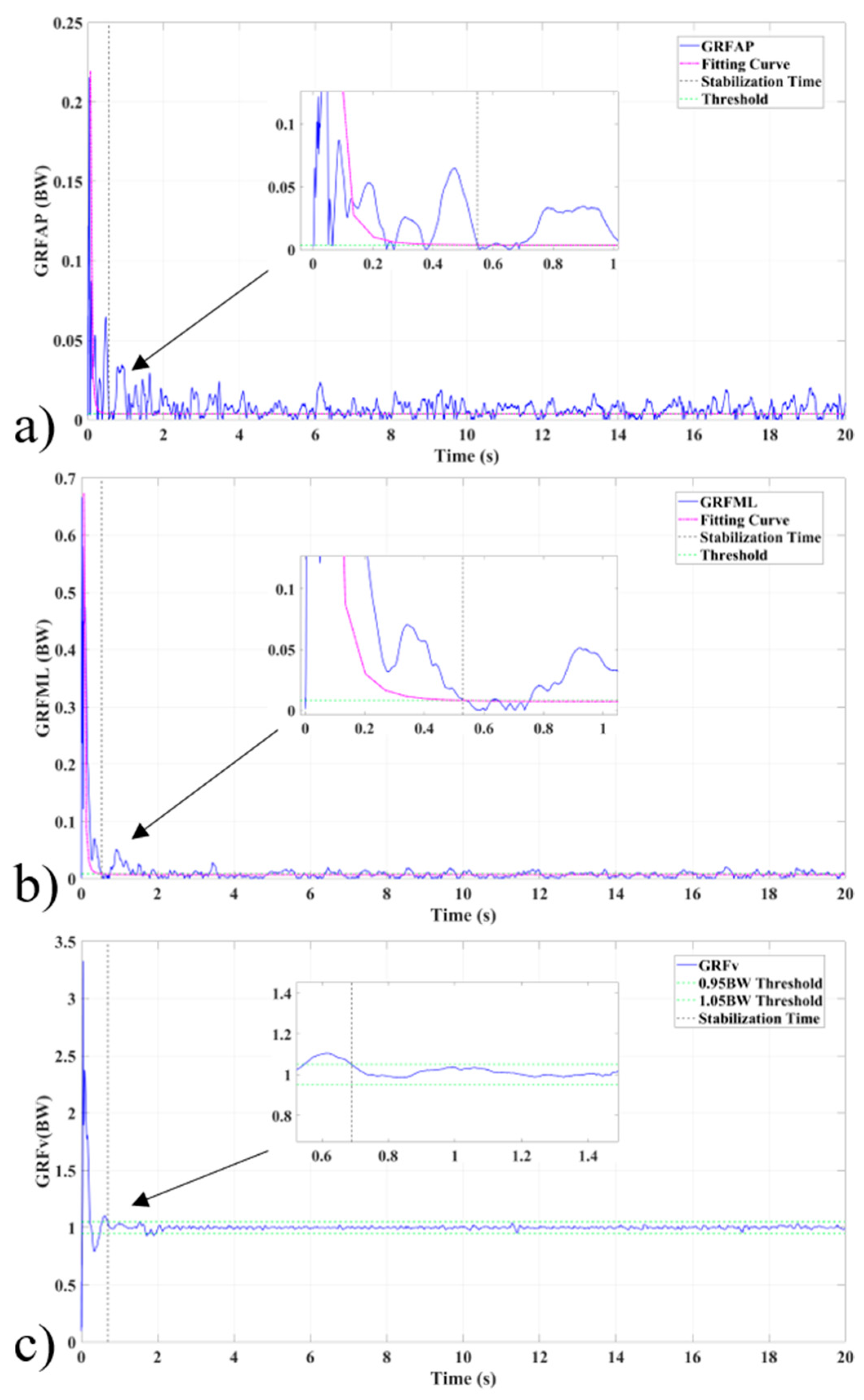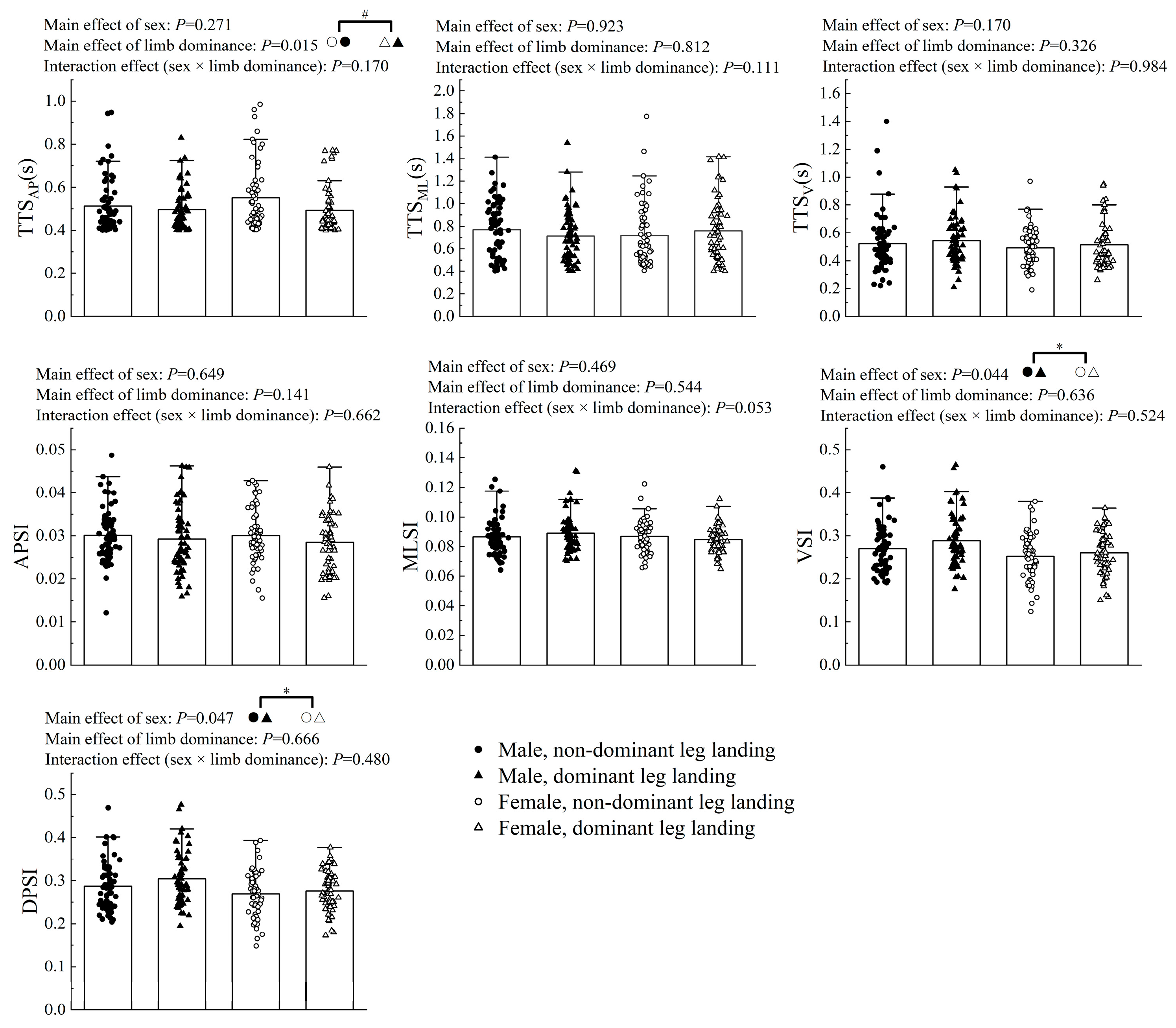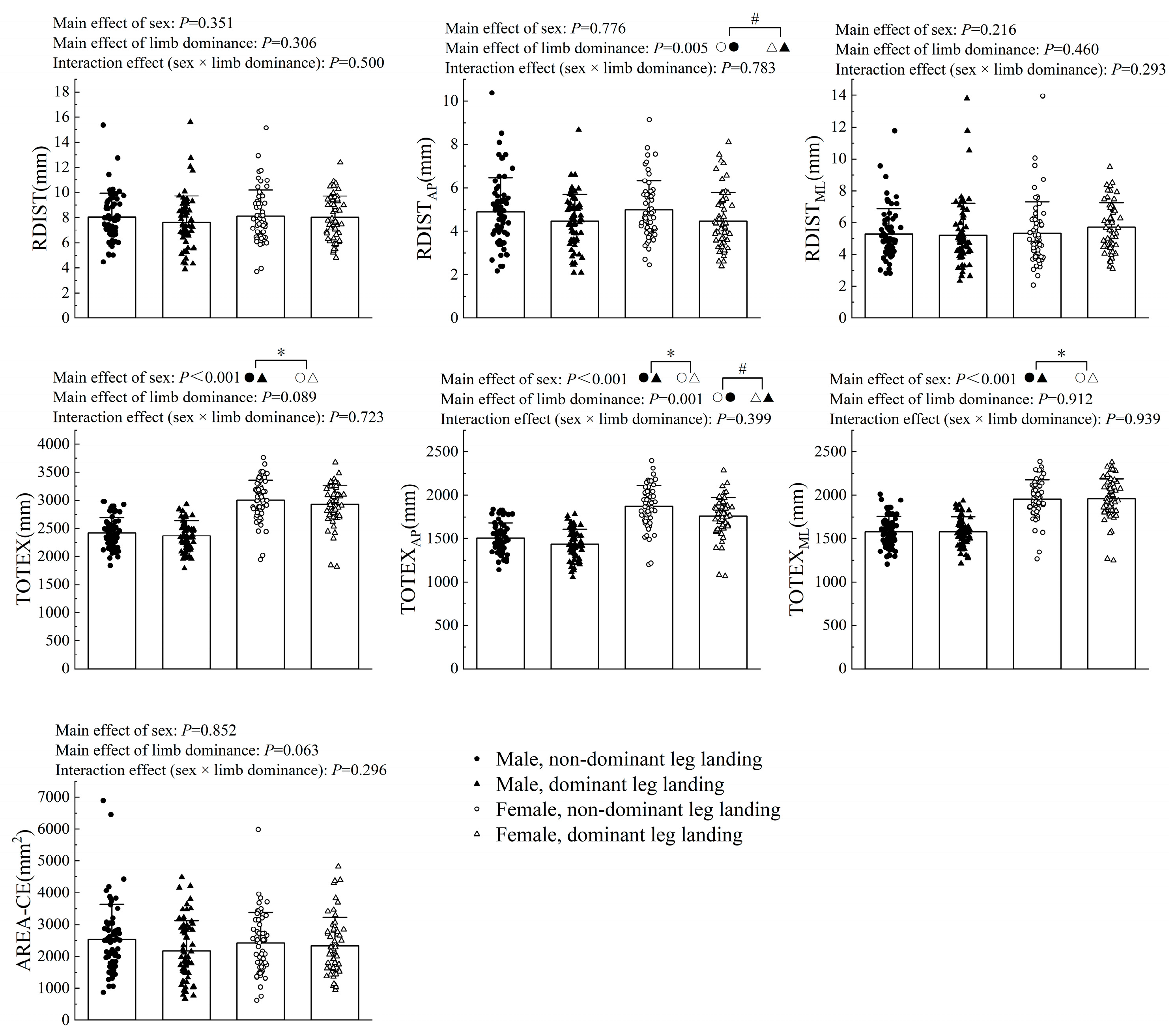Sex and Limb Dominance Differences in Postural Control Performance of Young Adults: A Third-Order Polynomial Decay Approach
Abstract
1. Introduction
2. Methods
2.1. Test Protocol
2.2. Data Acquisition and Processing
2.3. Main Outcome Measures
2.3.1. Time to Stabilization (TTS)
2.3.2. Dynamic Postural Stability Index (DPSI)
2.3.3. Root Mean Square Distance (RDIST)
2.3.4. Total Excursions (TOTEX)
2.3.5. 95% Confidence Ellipse Area (AREA-CE)
2.4. Statistical Analysis
3. Results
3.1. Dynamic Postural Stability Results
3.2. Static Postural Stability Results
4. Discussion
4.1. Sex and Limb Dominance Differences in Dynamic Postural Stability
4.2. Sex and Limb Dominance Differences in Static Postural Stability
4.3. Practical Applications of Polynomial Fitting Method
4.4. Limitations
5. Conclusions
Author Contributions
Funding
Informed Consent Statement
Data Availability Statement
Acknowledgments
Conflicts of Interest
Abbreviations
| COM | Center of mass |
| ACL | Anterior cruciate ligament |
| TTS | Time to stabilization |
| GRF | Ground reaction force |
| COP | Center of pressure |
| DPSI | Dynamic postural stability index |
| RDIST | Root mean square distance |
| TOTEX | Total excursions |
| AREA-CE | 95% Confidence ellipse area |
References
- Kang, H.G.; Dingwell, J.B. A Direct Comparison of Local Dynamic Stability During Unperturbed Standing and Walking. Exp. Brain Res. 2006, 172, 35–48. [Google Scholar] [CrossRef]
- Luo, W.; Huang, Z.; Li, H.; Zhong, T.; Chen, P.; Min, Y. Regulation of Static and Dynamic Balance in Healthy Young Adults: Interactions Between Stance Width and Visual Conditions. Front. Bioeng. Biotechnol. 2025, 13, 1538286. [Google Scholar]
- Böhm, H.; Hösl, M. Effect of Boot Shaft Stiffness on Stability Joint Energy and Muscular Co-Contraction During Walking on Uneven Surface. J. Biomech. 2010, 43, 2467–2472. [Google Scholar] [CrossRef] [PubMed]
- Jackson, L.L. Non-Fatal Occupational Injuries and Illnesses Treated in Hospital Emergency Departments in the United States. Inj. Prev. 2001, 7 (Suppl. 1), i21–i26. [Google Scholar] [CrossRef] [PubMed]
- An, Y.W. Neurophysiological Mechanisms Underlying Functional Knee Instability Following an Anterior Cruciate Ligament Injury. Exerc. Sci. 2018, 27, 109–117. [Google Scholar] [CrossRef]
- Culvenor, A.G.; Alexander, B.C.; Clark, R.A.; Collins, N.J.; Ageberg, E.; Morris, H.G.; Whitehead, T.S.; Crossley, K.M. Dynamic Single-Leg Postural Control Is Impaired Bilaterally Following Anterior Cruciate Ligament Reconstruction: Implications for Reinjury Risk. J. Orthop. Sports Phys. Ther. 2016, 46, 357–364. [Google Scholar] [CrossRef]
- Calisti, M.; Mohr, M.; Federolf, P. Bilateral Deficits in Dynamic Postural Stability in Females Persist Years After Unilateral ACL Injury and Are Modulated by the Match Between Injury Side and Leg Dominance. Brain Sci. 2023, 13, 1721. [Google Scholar] [CrossRef]
- Huurnink, A.; Fransz, D.P.; Kingma, I.; de Boode, V.A.; van Dieën, J.H. The Assessment of Single-Leg Drop Jump Landing Performance by Means of Ground Reaction Forces: A Methodological Study. Gait Posture 2019, 73, 80–85. [Google Scholar] [CrossRef]
- Wang, J.; Wang, X.; Fang, Z.; Lu, N.; Han, L. The Effect of FRAX on the Prediction of Osteoporotic Fractures in Urban Middle-Aged and Elderly Healthy Chinese Adults. Clinics 2017, 72, 289–293. [Google Scholar] [CrossRef]
- Dos’Santos, T.; Thomas, C.; Jones, P.A. Assessing Interlimb Asymmetries: Are We Heading in the Right Direction? Strength Cond. J. 2021, 43, 91–100. [Google Scholar] [CrossRef]
- Yeow, C.H.; Lee, P.V.S.; Goh, J.C.H. Effect of Landing Height on Frontal Plane Kinematics, Kinetics and Energy Dissipation at Lower Extremity Joints. J. Biomech. 2009, 42, 1967–1973. [Google Scholar] [CrossRef]
- van Melick, N.; Meddeler, B.M.; Hoogeboom, T.J.; Nijhuis-van der Sanden, M.W.G.; van Cingel, R.E.H. How to Determine Leg Dominance: The Agreement Between Self-Reported and Observed Performance in Healthy Adults. PLoS ONE 2017, 12, e0189876. [Google Scholar] [CrossRef]
- Cripps, A.J.; Hopper, L.S.; Joyce, C. Inter-Rater Reliability and Validity of the Australian Football League’s Kicking and Handball Tests. J. Sports Sci. Med. 2015, 14, 675. [Google Scholar]
- Fransz, D.P.; Huurnink, A.; de Boode, V.A.; Kingma, I.; van Dieën, J.H. Time Series of Ground Reaction Forces Following a Single Leg Drop Jump Landing in Elite Youth Soccer Players Consist of Four Distinct Phases. Gait Posture 2016, 50, 137–144. [Google Scholar] [CrossRef] [PubMed]
- Sun, W.; Wang, L.; Zhang, C.; Song, Q.; Gu, H.; Mao, D. Detraining Effects of Regular Tai Chi Exercise on Postural Control Ability in Older Women: A Randomized Controlled Trial. J. Exerc. Sci. Fit. 2018, 16, 55–61. [Google Scholar] [CrossRef] [PubMed]
- Kistler Instrumente AG. BioWare® User Manual, Version 5.3; Kistler Group: Winterthur, Switzerland, 2015. Available online: https://www.kistler.com (accessed on 15 August 2025).
- Fransz, D.P.; Huurnink, A.; Kingma, I.; van Dieën, J.H. How Does Postural Stability Following a Single Leg Drop Jump Landing Task Relate to Postural Stability During a Single Leg Stance Balance Task? J. Biomech. 2014, 47, 3248–3253. [Google Scholar] [CrossRef]
- Jafarnezhadgero, A.A.; Madadi-Shad, M.; McCrum, C.; Karamanidis, K. Effects of Corrective Training on Drop Landing Ground Reaction Force Characteristics and Lower Limb Kinematics in Older Adults with Genu Valgus: A Randomized Controlled Trial. J. Aging Phys. Act. 2019, 27, 9–17. [Google Scholar] [CrossRef]
- Richardson, M.C.; Chesterton, P.; Taylor, A.; Evans, W. The Effect of Surface on Knee Landing Mechanics and Muscle Activity During a Single-Leg Landing Task in Recreationally Active Females. Phys. Ther. Sport 2024, 69, 22–32. [Google Scholar] [CrossRef] [PubMed]
- MATLAB. Release 2020a; The MathWorks, Inc.: Natick, MA, USA, 2020; Available online: https://www.mathworks.com (accessed on 15 August 2025).
- Sawkins, K.; Refshauge, K.; Kilbreath, S.; Raymond, J. The Placebo Effect of Ankle Taping on Ankle Instability. Med. Sci. Sports Exerc. 2007, 39, 781–787. [Google Scholar] [CrossRef]
- Qi, L.; Zhou, M.; Mao, M.; Yang, J. The Static Balance Ability on Soft and Hard Support Surfaces in Older Adults with Mild Cognitive Impairment. PLoS ONE 2023, 18, e0295569. [Google Scholar] [CrossRef]
- Chawan, V.R.; Huber, M.; Burns, N.; Daniel, K. Person Identification and Tinetti Score Prediction Using Balance Parameters: A Machine Learning Approach to Determine Fall Risk. In Proceedings of the 15th International Conference on Pervasive Technologies Related to Assistive Environments, New York, NY, USA, 29 June–1 July 2022; pp. 203–212. [Google Scholar]
- Chao, T.C.; Jiang, B.C. A Comparison of Postural Stability During Upright Standing Between Normal and Flatfooted Individuals, Based on COP-Based Measures. Entropy 2017, 19, 76. [Google Scholar] [CrossRef]
- Gribble, P.A.; Mitterholzer, J.; Myers, A.N. Normalizing Considerations for Time to Stabilization Assessment. J. Sci. Med. Sport 2012, 15, 159–163. [Google Scholar] [CrossRef]
- Wikstrom, E.A.; Tillman, M.D.; Kline, K.J.; Borsa, P.A. Gender and Limb Differences in Dynamic Postural Stability During Landing. Clin. J. Sport Med. 2006, 16, 311–315. [Google Scholar] [CrossRef]
- Watabe, T.; Takabayashi, T.; Tokunaga, Y.; Kubo, M. Copers Adopt an Altered Dynamic Postural Control Compared to Individuals with Chronic Ankle Instability and Controls in Unanticipated Single-Leg Landing. Gait Posture 2022, 92, 378–382. [Google Scholar] [CrossRef]
- Dallinga, J.M.; van der Does, H.T.D.; Benjaminse, A.; Lemmink, K.A. Dynamic Postural Stability Differences Between Male and Female Players with and Without Ankle Sprain. Phys. Ther. Sport 2016, 17, 69–75. [Google Scholar] [CrossRef]
- Aizawa, J.; Hirohata, K.; Ohji, S.; Ohmi, T.; Yagishita, K. Limb-Dominance and Gender Differences in the Ground Reaction Force During Single-Leg Lateral Jump-Landings. J. Phys. Ther. Sci. 2018, 30, 387–392. [Google Scholar] [CrossRef]
- Laughlin, W.A.; Weinhandl, J.T.; Kernozek, T.W.; Cobb, S.C.; Keenan, K.G.; O’COnnor, K.M. The Effects of Single-Leg Landing Technique on ACL Loading. J. Biomech. 2011, 44, 1845–1851. [Google Scholar] [CrossRef]
- Lephart, S.M.; Abt, J.P.; Ferris, C.M. Neuromuscular Contributions to Anterior Cruciate Ligament Injuries in Females. Curr. Opin. Rheumatol. 2002, 14, 168–173. [Google Scholar] [CrossRef]
- Ali, N.; Rouhi, G.; Robertson, G. Gender, Vertical Height and Horizontal Distance Effects on Single-Leg Landing Kinematics: Implications for Risk of Non-Contact ACL Injury. J. Hum. Kinet. 2013, 37, 27–38. [Google Scholar] [CrossRef]
- Terra, M.B.; Da Silva, R.A.; Bueno, M.E.B.; Ferraz, H.B.; Smaili, S.M. Center of Pressure-Based Balance Evaluation in Individuals with Parkinson’s Disease: A Reliability Study. Physiother. Theory Pract. 2020, 36, 826–833. [Google Scholar] [CrossRef]
- Ruhe, A.; Fejer, R.; Walker, B. The Test–Retest Reliability of Centre of Pressure Measures in Bipedal Static Task Conditions–A Systematic Review of the Literature. Gait Posture 2010, 32, 436–445. [Google Scholar] [CrossRef]
- Li, Z.; Liang, Y.-Y.; Wang, L.; Sheng, J.; Ma, S.-J. Reliability and Validity of Center of Pressure Measures for Balance Assessment in Older Adults. J. Phys. Ther. Sci. 2016, 28, 1364–1367. [Google Scholar] [CrossRef]
- Nguyen, U.-S.D.T.; Kiel, D.P.; Li, W.; Galica, A.M.; Kang, H.G.; Casey, V.A.; Hannan, M.T. Correlations of Clinical and Laboratory Measures of Balance in Older Men and Women. Arthritis Care Res. 2012, 64, 1895–1902. [Google Scholar] [CrossRef]
- Bryant, E.C.; Trew, M.E.; Bruce, A.M.; Kuisma, R.; Smith, A. Gender Differences in Balance Performance at the Time of Retirement. Clin. Biomech. 2005, 20, 330–335. [Google Scholar] [CrossRef]
- Lanshammar, K.; Ribom, E.L. Differences in Muscle Strength in Dominant and Non-Dominant Leg in Females Aged 20–39 Years: A Population-Based Study. Phys. Ther. Sport 2011, 12, 76–79. [Google Scholar] [CrossRef]
- Sell, T.C.; Lovalekar, M.T.; Nagai, T.; Wirt, M.D.; Abt, J.P.; Lephart, S.M. Gender Differences in Static and Dynamic Postural Stability of Soldiers in the Army’s 101st Airborne Division (Air Assault). J. Sport Rehabil. 2018, 27, 126–131. [Google Scholar] [CrossRef]
- Goli, F.; Taheri, M. Biosemiotics Approach to Biomechanics: Integrating Symbolic and Sensory-Motor Systems for Enhanced Health and Performance. Int. J. Body, Mind Cult. 2025, 12, 4–15. [Google Scholar] [CrossRef]
- Ahmadpoor, M.; Bragazzi, N.L. The Effects of Strength Training on Motor Control and Functional Performance in Older Adults: A Narrative Review. Int. J. Sport Stud. Health 2025, 8, 12–21. [Google Scholar] [CrossRef]
- Avogaro, A.; Cunico, F.; Rosenhahn, B.; Setti, F. Markerless Human Pose Estimation for Biomedical Applications: A Survey. Front. Comput. Sci. 2023, 5, 1153160. [Google Scholar] [CrossRef]
- Barberi, E.; Chillemi, M.; Cucinotta, F.; Sfravara, F. Fast Three-Dimensional Posture Reconstruction of Motorcyclists Using OpenPose and a Custom MATLAB Script. Sensors 2023, 23, 7415. [Google Scholar] [CrossRef]




| Sex | N | Age (y) | Height (cm) | Weight (kg) | BMI(kg/m2) |
|---|---|---|---|---|---|
| Male | 66 | 20.26 ± 1.42 | 180.23 ± 4.23 | 72.03 ± 7.62 | 22.17 ± 2.19 |
| Female | 60 | 20.30 ± 2.71 | 166.22 ± 5.60 | 57.81 ± 7.50 | 20.90 ± 2.16 |
| Total | 126 | 20.28 ± 2.12 | 173.56 ± 8.57 | 65.26 ± 10.37 | 21.56 ± 2.26 |
Disclaimer/Publisher’s Note: The statements, opinions and data contained in all publications are solely those of the individual author(s) and contributor(s) and not of MDPI and/or the editor(s). MDPI and/or the editor(s) disclaim responsibility for any injury to people or property resulting from any ideas, methods, instructions or products referred to in the content. |
© 2025 by the authors. Licensee MDPI, Basel, Switzerland. This article is an open access article distributed under the terms and conditions of the Creative Commons Attribution (CC BY) license (https://creativecommons.org/licenses/by/4.0/).
Share and Cite
Sun, Y.; Wu, H.; Zhang, X.; Liu, J.; Wang, G.; Duan, L.; Gao, Y. Sex and Limb Dominance Differences in Postural Control Performance of Young Adults: A Third-Order Polynomial Decay Approach. Symmetry 2025, 17, 1734. https://doi.org/10.3390/sym17101734
Sun Y, Wu H, Zhang X, Liu J, Wang G, Duan L, Gao Y. Sex and Limb Dominance Differences in Postural Control Performance of Young Adults: A Third-Order Polynomial Decay Approach. Symmetry. 2025; 17(10):1734. https://doi.org/10.3390/sym17101734
Chicago/Turabian StyleSun, Yang, Hanbing Wu, Xingchen Zhang, Jiujiang Liu, Guanying Wang, Lian Duan, and Yuan Gao. 2025. "Sex and Limb Dominance Differences in Postural Control Performance of Young Adults: A Third-Order Polynomial Decay Approach" Symmetry 17, no. 10: 1734. https://doi.org/10.3390/sym17101734
APA StyleSun, Y., Wu, H., Zhang, X., Liu, J., Wang, G., Duan, L., & Gao, Y. (2025). Sex and Limb Dominance Differences in Postural Control Performance of Young Adults: A Third-Order Polynomial Decay Approach. Symmetry, 17(10), 1734. https://doi.org/10.3390/sym17101734






